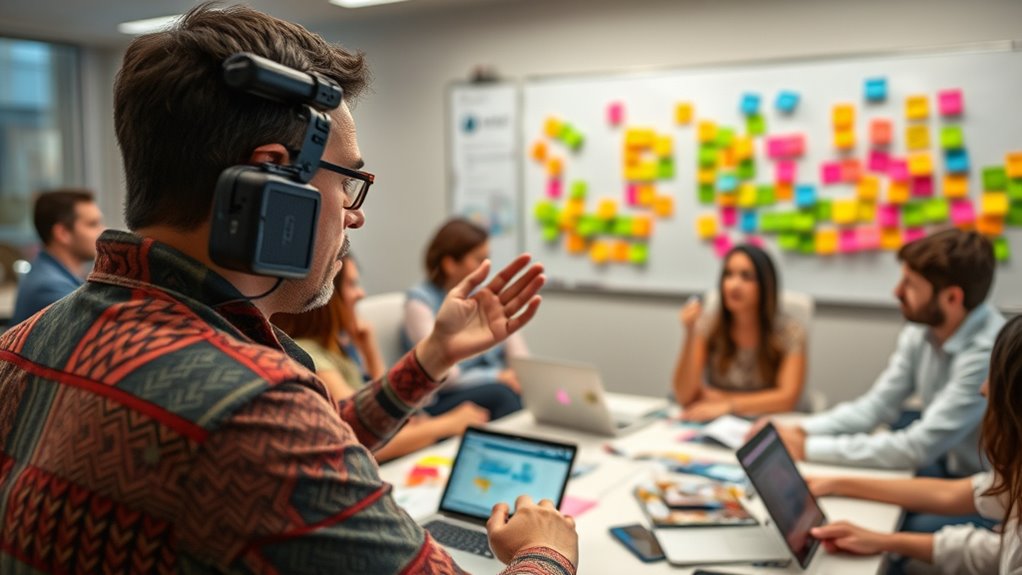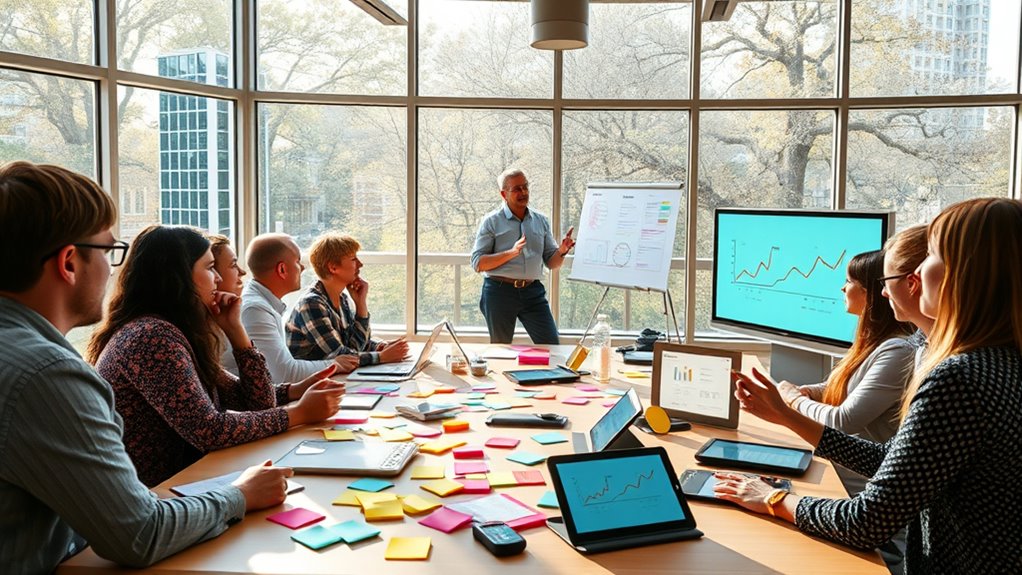When plans unexpectedly explode, stay alert for early signs like disengagement, confusion, or body language cues signaling trouble. Cultivate a flexible mindset, viewing your session plan as a guide rather than set in stone, so you can adapt swiftly. Use active listening to interpret audience signals and assess the situation rapidly. Employ dynamic tools and quick reframes to re-engage participants and maintain momentum. If you want to master proactive, responsive facilitation, exploring these strategies further will give you the confidence to turn disruptions into opportunities.
Key Takeaways
- Monitor audience cues like body language and questions to identify early signs of disruption and adjust accordingly.
- Maintain a flexible mindset by viewing plans as guides, allowing quick pivots based on group dynamics.
- Practice active listening to interpret non-verbal signals and reassess the session’s flow in real time.
- Use rapid reframing techniques to realign activities with participant needs, fostering engagement and trust.
- Employ adaptable resources and engagement strategies, such as quick polls or breakout sessions, to sustain momentum during disruptions.
Recognizing Early Signs of Plan Disruption

Recognizing early signs of plan disruption is essential for maintaining control and adjusting strategies promptly. When you anticipate disruptions, you stay alert to recognizing signals that indicate things aren’t going as planned. These signals might include sudden changes in participant engagement, unexpected questions, or shifts in group dynamics. Pay attention to subtle cues like body language, tone of voice, or hesitations that suggest discomfort or confusion. By honing your ability to spot these early warning signs, you can intervene before small issues escalate. Staying attentive helps you adapt on the fly and keep the group aligned with your objectives. Being familiar with tuning techniques can also help you adjust your approach to better accommodate unexpected changes. Anticipating disruptions and recognizing signals quickly allow you to maintain momentum and foster a responsive, flexible facilitation approach.
Cultivating a Mindset of Flexibility and Openness

How can you develop a mindset that embraces flexibility and openness during facilitation? It starts with a mindset shift—recognizing that plans are guides, not rigid rules. To foster adaptability skills, stay curious and view surprises as opportunities to learn rather than obstacles. Practice releasing control over every detail and focus on the bigger picture. Embrace a growth mindset by reflecting on past experiences where flexibility led to better outcomes. Cultivate patience and trust in your ability to navigate unexpected changes. By consciously adopting an open attitude, you’ll become more responsive and resilient, enabling you to adjust seamlessly when plans shift. Additionally, understanding the importance of attention to detail in adapting to new circumstances can enhance your responsiveness. This mindset not only benefits your facilitation but also encourages participants to be more adaptable and engaged.
Building a Flexible Session Design From the Start

To create a session that remains adaptable from the outset, you need to incorporate flexibility into your session planning. This involves designing activities and discussions that can be easily adjusted if needed. Develop contingency strategies for potential disruptions, such as alternative activities or discussion prompts, so you’re prepared for unexpected changes. Consider pacing, allowing buffer time for shifts without disrupting your overall flow. Keep your objectives clear but flexible, enabling you to pivot as necessary. Use modular content that can be expanded or condensed based on the group’s needs. Incorporating auditory processing considerations into your planning can help tailor the session to diverse needs. By integrating these elements into your initial design, you set the stage for a responsive session that can adapt smoothly, ensuring engagement and productivity even when plans change unexpectedly.
Developing Active Listening Skills to Read the Room

Developing active listening skills is essential for accurately reading the room and responding effectively to your audience. Pay close attention to non-verbal cues like facial expressions, body language, and gestures, which reveal unspoken emotions and engagement levels. Use your emotional intelligence to interpret these signals, understanding underlying feelings that may not be verbally expressed. Show you’re genuinely listening by maintaining eye contact, nodding, and providing appropriate responses. Avoid distractions and stay present in the moment, which helps you pick up on subtle cues. By honing your active listening, you can gauge the group’s mood and adjust your facilitation style accordingly. This awareness enables you to respond more authentically and foster a collaborative, receptive atmosphere. Incorporating sound vibrations into your awareness can further enhance your ability to tune into the emotional state of the group.
Techniques for Rapid Reassessment and Decision-Making

You need to quickly identify when group dynamics shift so you can adjust your approach. Prioritize immediate actions that address the most pressing issues first. Mastering these techniques helps you stay responsive and effective in dynamic situations. Recognizing success metrics can provide valuable insights into whether your adjustments are positively impacting the group.
Spotting Shifting Dynamics
Recognizing shifting dynamics quickly is essential for making effective decisions in any facilitation process. Changes in group dynamics often signal that the current approach may need adjustment. Pay close attention to non-verbal cues, such as body language or tone shifts, which can reveal disengagement or rising tension. Notice how session pacing affects energy levels—if conversations stall or become chaotic, it’s a sign to reevaluate. Track patterns in participation and feedback; if certain voices dominate or others withdraw, it indicates a shift in group cohesion. By staying alert to these signs, you can adapt your facilitation style, redirect focus, or introduce new activities to realign the session with its objectives. Rapidly identifying these signals helps maintain momentum and ensures productive outcomes. Incorporating powerful persuasive words can further enhance your ability to influence and motivate participants during critical moments.
Prioritizing Immediate Actions
When faced with shifting group dynamics or emerging issues, quick and effective reassessment is essential to keep the facilitation on track. Prioritize immediate actions by quickly identifying the most pressing concerns and addressing them first. Use your emotional resilience to stay calm and focused, even if tensions rise or plans fall apart. Practice proactive communication by clearly articulating the new priorities to the group, ensuring everyone understands the next steps. This approach helps prevent overwhelm and keeps momentum moving forward. Remember, rapid decision-making isn’t about rushing but about distinguishing what needs urgent attention from what can wait. Developing a good understanding of contrast ratio can help you assess the visual impact of your decisions and adjustments more effectively. By honing this skill, you maintain control, foster trust, and guide the group through uncertainty efficiently.
Using Audience Input to Redirect and Reframe Activities

As a facilitator, you can pick up on audience cues to know when to shift focus or reframe activities. When you read their reactions, you can adjust your approach on the spot to keep engagement high. This ability to respond quickly helps you redirect the session effectively and meet participants’ needs. Additionally, recognizing passive voice in your speech can make your communication clearer and more direct.
Reading Audience Cues
Have you ever noticed how audience reactions can instantly signal whether your activity hits the mark or needs a shift? By paying close attention to body language, you can spot signs of engagement or discomfort—like leaning forward or crossing arms. Vocal cues, such as hesitant pauses or a lack of enthusiasm in their voices, also reveal how they’re responding. If you see closed-off postures or hear monotone responses, it’s a clear signal to adjust. Instead of sticking rigidly to your plan, use these cues to reframe your approach on the spot. Asking quick questions or changing your tone encourages participation and keeps energy levels high. Reading these subtle signals helps you stay responsive, ensuring your facilitation remains dynamic and aligned with your audience’s needs. Additionally, understanding audience engagement allows you to tailor your content more effectively in real time.
Shifting Activity Focus
Noticing audience cues isn’t just about understanding their reactions—it also provides opportunities to adjust your activities in real time. When group dynamics shift or cultural considerations influence engagement, you can pivot your focus to keep participation lively and relevant. If you sense fatigue or confusion, consider shifting from a discussion to a quick activity or reflection to reenergize the group. Be attentive to cues that suggest the current activity isn’t resonating, and don’t hesitate to reframe or redirect based on audience input. Flexibility helps maintain momentum and respects diverse cultural perspectives, ensuring everyone feels included. Recognizing passive voice detection helps you identify areas where your writing can become more direct and engaging. By staying responsive and adaptable, you create a dynamic environment where activities serve the group’s evolving needs, fostering meaningful engagement and deeper understanding.
Reframing on Demand
When audience input signals that an activity isn’t hitting the mark, effective facilitators quickly reframe the session to better meet participants’ needs. This requires a mindset shift, embracing flexibility over sticking to the original plan. By actively listening and observing cues, you can identify opportunities to pivot, using audience feedback as a guide. Reframing on demand demonstrates adaptability skills, showing participants that their input matters. Instead of forcing a plan, you adjust the activity’s focus, framing, or approach to maintain engagement and relevance. This responsiveness builds trust and encourages participation. Mastering this skill helps you stay agile, turning unexpected feedback into a powerful tool for dynamic facilitation. Ultimately, reframing on demand keeps your session aligned with your goals and your audience’s evolving needs.
Employing Adaptive Tools and Resources in Real-Time

How can facilitators effectively adapt their tools and resources on the spot to meet evolving group needs? The key is dynamic resource allocation—shifting and reallocating materials or tools as the session unfolds. You should stay alert to cues indicating changing priorities or engagement levels, then quickly switch to more relevant resources. Real-time tool adaptation involves customizing or simplifying digital platforms, handouts, or activities to fit the moment’s demands. This flexibility guarantees the group remains focused and productive, even when original plans falter. By having a versatile set of tools prepared and being ready to pivot, you maintain control and support group responsiveness. This approach keeps the momentum going and fosters a sense of adaptability that encourages active participation.
Strategies for Maintaining Engagement Amid Uncertainty

Maintaining engagement during uncertain moments requires proactive strategies that keep participants invested despite unpredictability. One effective approach is using icebreaker techniques to re-energize the group and foster connection, especially when plans shift unexpectedly. These activities break the ice and create a relaxed atmosphere, making participants more willing to contribute. In virtual engagement settings, keep interactions dynamic by incorporating quick polls, chat prompts, or breakout sessions that encourage active participation. Be transparent about changes, and invite input to make everyone feel involved. Flexibility is key; adapt activities on the fly to suit the mood and energy levels. By combining engaging icebreakers with adaptable virtual methods, you guarantee participants stay focused, motivated, and connected—even when plans go awry.
Reflecting and Learning From Unexpected Challenges

Reflecting on unexpected challenges allows you to identify what worked and what didn’t, turning setbacks into valuable learning opportunities. When you analyze the situation, you develop better scenario adaptation skills, enabling you to respond more effectively in future disruptions. This reflection helps build resilience, strengthening your ability to stay calm and focused under pressure. By examining what caused the unexpected issue, you can refine your approach and prepare for similar challenges ahead. Embracing these moments as learning opportunities transforms setbacks into growth experiences. Over time, this process enhances your capacity to pivot quickly and maintain momentum, even when plans fall apart. Consistent reflection not only sharpens your facilitation skills but also fosters a mindset geared toward continuous improvement and adaptable leadership.
Frequently Asked Questions
How Can I Anticipate Unexpected Disruptions Before They Occur?
To anticipate unexpected disruptions, you should focus on contingency planning and spontaneity management. Identify potential risks early and develop backup plans to stay flexible. Keep an eye on your environment for signs of change and be ready to adapt quickly. Practice staying calm under pressure, which helps you manage spontaneity effectively. By preparing for uncertainties, you’ll minimize surprises and maintain control when plans unexpectedly shift.
What Are Common Pitfalls in Adaptive Facilitation?
Think of adaptive facilitation as sailing through choppy waters—you need steady hands and keen eyes. A common pitfall is losing participant engagement when plans shift suddenly, leaving everyone adrift. Relying too heavily on scripted facilitation techniques can make you seem inflexible, causing disengagement. Instead, stay flexible, read the room, and adapt your approach on the fly to keep everyone engaged and the conversation flowing smoothly.
How Do I Balance Structure With Flexibility Effectively?
You need to balance structure with flexibility by embracing dynamic planning and improvisational techniques. Start with a clear framework to guide the session, but stay open to adapting as new ideas or challenges emerge. Use active listening and quick adjustments to keep the flow smooth, ensuring participants feel heard and engaged. This approach allows you to maintain order while responding effectively to unexpected changes, making your facilitation more responsive and impactful.
What if Audience Input Contradicts the Original Plan?
Think of your session as a river flowing around obstacles. If audience input contradicts your plan, acknowledge their expectations and adapt smoothly. Respect session boundaries while incorporating their perspectives to keep engagement alive. Flexibility doesn’t mean losing control; it means steering with purpose. By listening actively and adjusting thoughtfully, you turn surprises into opportunities, ensuring your facilitation remains relevant and impactful without sacrificing the session’s core goals.
How Can I Build Resilience After a Disruptive Session?
After a disruptive session, you can build resilience by embracing mindset shifts that see setbacks as growth opportunities. Use resilience strategies like reflecting on what went wrong, learning from feedback, and maintaining focus on your goals. Remember, every challenge helps you improve. Keep a positive attitude, adapt quickly, and view disruptions as chances to strengthen your facilitation skills, making you more prepared for future unexpected situations.
Conclusion
Just like a skilled surfer rides unexpected waves, your ability to adapt in facilitation keeps the session flowing smoothly. When plans suddenly shift, your flexibility turns chaos into opportunity. Remember, every twist is a chance to reconnect with your audience and surf the new tide. Embrace the unpredictability—it’s where true mastery happens. With practice, you’ll find that the most memorable moments often come from riding those unexpected waves with confidence and ease.









